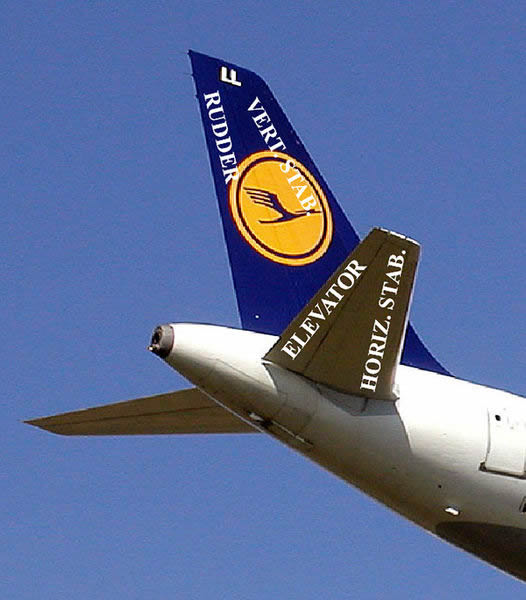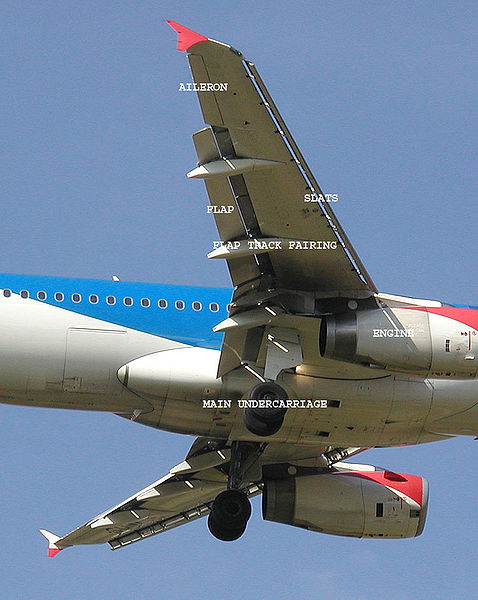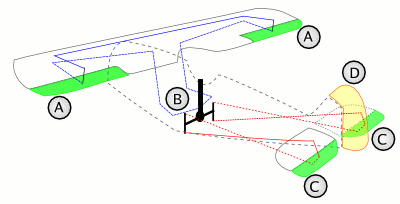Aircraft flight control surfaces allow a pilot to adjust and control the aircraft's flight attitude.
Development of an effective set of flight controls was a critical advance in the development of the aircraft. Early efforts at fixed-wing aircraft design succeeded in generating sufficient lift to get the aircraft off the ground, but once aloft, the aircraft proved uncontrollable, often with disastrous results. The development of effective flight controls is what allowed stable flight.
This article describes controls used on a fixed wing aircraft of conventional design. Other fixed wing aircraft configurations may use different control surfaces but the basic principles remain. The controls (stick and rudder) for rotary wing aircraft (helicopter or autogyro) accomplish the same motions about the 3 axes of rotation, but manipulate the rotating flight controls (main rotor disk and tail rotor disk) in a completely different manner.

Axes of motion
Flight dynamics
Rotation around the three axesAn aircraft is free to rotate around three axes which are perpendicular to each other and intersect at the plane's center of gravity (CG). To control position and direction a pilot must be able to control rotation about each of them.
Vertical axis
The vertical axis passes through the plane from top to bottom. Rotation about this axis is called yaw. Yaw changes the direction the aircraft's nose is pointing, left or right. The primary control of yaw is with the rudder. Ailerons also have a secondary effect on yaw.
Plane control and motion.
Longitudinal axis
The longitudinal axis passes through the plane from nose to tail. Rotation about this axis is called bank or roll. Bank changes the orientation of the aircraft's wings with respect to the downward force of gravity. The pilot changes bank angle by increasing the lift on one wing and decreasing it on the other. This differential lift causes bank rotation around the longitudinal axis. The ailerons are the primary control of bank. The rudder also has a secondary effect on bank.

Lateral axis
The lateral axis passes through the plane from wingtip to wingtip. Rotation about this axis is called pitch. Pitch changes the vertical direction the aircraft's nose is pointing. The elevators are the primary control of pitch.
It is important to note that these axes move with the aircraft, and change relative to the earth as the aircraft moves. For example, for an aircraft whose left wing is pointing straight down, its "vertical" axis is parallel with the ground, while its "lateral" axis is perpendicular to the ground.
Main control surfaces
The main control surfaces of a fixed-wing aircraft are attached to the airframe on hinges or tracks so they may move and thus deflect the air stream passing over them. This redirection of the air stream generates an unbalanced force to rotate the plane about the associated axis.
Ailerons
Ailerons are mounted on the trailing edge of each wing near the wingtips, and move in opposite directions. When the pilot moves the stick left, or turns the wheel counter-clockwise, the left aileron goes up and the right aileron goes down. A raised aileron reduces lift on that wing and a lowered one increases lift, so moving the stick left causes the left wing to drop and the right wing to rise. This causes the plane to bank left and begin to turn to the left. Centering the stick returns the ailerons to neutral maintaining the bank angle. The plane will continue to turn until opposite aileron motion returns the bank angle to zero to fly straight.
Elevator
An elevator is mounted on the back edge of the horizontal stabilizer on each side of the fin in the tail. They move up and down together. When the pilot pulls the stick backward, the elevators go up. Pushing the stick forward causes the elevators to go down. Raised elevators push down on the tail and cause the nose to pitch up. This makes the wings fly at a higher angle of attack which generates more lift and more drag. Centering the stick returns the elevators to neutral and stops the change of pitch. Many aircraft use a stabilator — a moveable horizontal stabilizer — in place of an elevator. Some aircraft, such as an MD-80, use a control tab within the elevator surface to aerodynamically backdrive the main surface into position. The direction of travel of the control tab will thus be in a direction opposite to the main control surface. It is for this reason that an MD-80 tail looks like it has a 'split' elevator system.
Rudder
The rudder is typically mounted on the back edge of the fin in the empennage. When the pilot pushes the left pedal, the rudder deflects left. Pushing the right pedal causes the rudder to deflect right. Deflecting the rudder right pushes the tail left and causes the nose to yaw right. Centering the rudder pedals returns the rudder to neutral and stops the yaw.
Control surfaces
1. Winglet
2. Low-Speed Aileron
3. High-Speed Aileron
4. Flap track fairing
5. Krüger flaps
6. Slats
7. Three slotted inner flaps
8. Three slotted outer flaps
9. Spoilers
10. Spoilers-Air brakes
Secondary effects of controls
Ailerons
The ailerons primarily control roll. Whenever lift is increased, induced drag is also increased. When the stick is moved left to bank the aircraft to the left, the right aileron is lowered which increases lift on the right wing and therefore increases induced drag on the right wing. Using ailerons causes adverse yaw, meaning the nose of the aircraft yaws in a direction opposite to the aileron application. When moving the stick to the left to bank the wings, adverse yaw moves the nose of the aircraft to the right. Adverse yaw is more pronounced for light aircraft with long wings, such as gliders. It is counteracted by the pilot with the rudder. Differential ailerons are ailerons which have been rigged such that the downgoing aileron deflects less than the upward-moving one, reducing adverse yaw.
Rudder
Using the rudder causes one wing to move forward faster than the other. Increased speed means increased lift, and hence rudder use causes a roll effect. Also, since rudders generally extend above the aircraft's center of gravity, a torque is imparted to the aircraft resulting in an adverse bank. Pushing the rudder to the right not only pulls the tail to the left and the nose to the right, but it also "spins" the aircraft as if a left turn were going to be made. Out of all the control inputs, rudder input creates the greatest amount of adverse effect. For this reason ailerons and rudder are generally used together on light aircraft. When turning to the left, the control column is moved left, and adequate left rudder is applied. If too much left rudder is applied the aircraft could enter a skid and then enter a spin.
Turning the aircraft
Unlike a boat, turning an aircraft is not normally carried out with the rudder. With aircraft, the turn is caused by the horizontal component of lift. The lifting force, perpendicular to the wings of the aircraft, is tilted in the direction of the intended turn by rolling the aircraft into the turn. As the bank angle is increased the lifting force, which was previously acting only in the vertical, is split into two components: One acting vertically and one acting horizontally.
If the total lift is kept constant, the vertical component of lift will decrease. As the weight of the aircraft is unchanged, this would result in the aircraft descending if not countered. To maintain level flight requires increased positive (up) elevator to increase the angle of attack, increase the total lift generated and keep the vertical component of lift equal with the weight of the aircraft. This cannot continue indefinitely. The wings can only generate a finite amount of lift at a given air speed. As the load factor (commonly called G loading) is increased an accelerated aerodynamic stall will occur, even though the airplane is above its 1G stall speed.
The total lift (load factor) required to maintain level flight is directly related to the bank angle. This means that for a given airspeed, level flight can only be maintained up to a certain given angle of bank. Beyond this angle of bank, the aircraft will suffer an accelerated stall if the pilot attempts to generate enough lift to maintain level flight.
Alternate main control surfaces
Some aircraft configurations have non-standard primary controls. For example instead of elevators at the back of the stabilizers, the entire tailplane may change angle. Some aircraft have a tail in the shape of a V, and the moving parts at the back of those combine the functions of elevators and rudder. Delta wing aircraft may have "elevons" at the back of the wing, which combine the functions of elevators and ailerons.
Secondary control surfaces
Trim
Trimming controls allow a pilot to balance the lift and drag being produced by the wings and control surfaces over a wide range of load and airspeed. This reduces the effort required to adjust or maintain a desired flight attitude.
Elevator trim
Elevator trim balances the control force necessary to maintain the aerodynamic down force on the tail. Whilst carrying out certain flight exercises, a lot of trim could be required to maintain the desired angle of attack. This mainly applies to slow flight, where maintaining a nose-up attitude requires a lot of trim. Elevator trim is correlated with the speed of the airflow over the tail, thus airspeed changes to the aircraft require re-trimming. An important design parameter for aircraft is the stability of the aircraft when trimmed for level flight. Any disturbances such as gusts or turbulence will be damped over a short period of time and the aircraft will return to its level flight trimmed airspeed.
Trimming tail plane
Except for very light aircraft, trim tabs on elevators are unable to provide the force and range of motion desired. To provide the appropriate trim force the entire horizontal tail plane is made adjustable in pitch. This allows the pilot to select exactly the right amount of positive or negative lift from the tail plane while reducing drag from the elevators.
Control horn
A control horn is a section of control surface which projects ahead of the pivot point. It generates a force which tends to increase the surface's deflection thus reducing the control pressure experienced by the pilot. Control horns may also incorporate a counterweight which helps to balance the control and prevent it from "fluttering" in the airstream. Some designs feature separate anti-flutter weights.
Spring trim
In the simplest cases trimming is done by a mechanical spring (or bungee) which adds appropriate force to augment the pilot's control input. The spring is usually connected to an elevator trim lever to allow the pilot to set the spring force applied.
Rudder and aileron trim
Trim doesn't only apply to the elevator, as there is also trim for the rudder and ailerons. The use of this is to counter the effects of slip stream, or to counter the effects of the centre of gravity being to one side. This can be caused by a larger weight on one side of the aircraft compared to the other, such as when one fuel tank has a lot more fuel in it than the other, or when there are heavier people on one side of the aircraft than the other.
Spoilers
On low drag aircraft like sailplanes, spoilers are used to disrupt airflow over the wing and greatly increase the amount of drag. This allows a glider pilot to lose altitude without gaining excessive airspeed. Spoilers are sometimes called "lift dumpers". Spoilers that can be used asymmetrically are called spoilerons and are able to affect an aircraft's roll.
Flaps
Flaps are mounted on the trailing edge of each wing on the inboard section of each wing (near the wing roots). They are deflected down to increase the effective curvature of the wing. Flaps raise the Maximum Lift Coefficient of the aircraft and therefore reduce its stalling speed. They are used during low speed, high angle of attack flight including take-off and descent for landing. Some aircraft are equipped with "flapperons", which are more commonly called "inboard ailerons". These devices function primarily as ailerons, but on some aircraft, will "droop" when the flaps are deployed, thus acting as both a flap and a roll-control inboard aileron.
Slats
Slats, also known as Leading Edge Devices, are extensions to the front of a wing for lift augmentation, and are intended to reduce the stalling speed by altering the airflow over the wing. Slats may be fixed or retractable - fixed slats (e.g. as on the Fieseler Fi 156 Storch) give excellent slow speed and STOL capabilities, but compromise higher speed performance. Retractable slats, as seen on most airliners, provide reduced stalling speed for take-off and landing, but are retracted for cruising.
Air brakes
Air brakes, also called spoilers, are used on high speed aircraft to increase drag. On a typical airliner, for example, the spoilers are a series of panels on the upper surface of the wing which deploy upwards to disrupt airflow over the wing, thus adding drag. The number of panels that deploy, as well as the degree to which they deploy, depends on the regime of flight in which they are used. For example, if a pilot must descend quickly without increasing speed, he may select a speed brake setting for the desired effect. In such a case, only certain spoiler panels will deploy to create the most efficient reduction in speed without overstressing the wing. On most airliners, spoiler panels on the wings mix with aileron inputs to enhance roll control. For example, a left bank will engage the ailerons as well as deploy certain spoiler panels on the down-going wing. Ground spoilers are essentially similar to flight spoilers, except that they deploy upon touchdown on the runway, and include all spoiler panels for maximum "lift dump". After touchdown, the ground spoilers deploy, and "dump" the lift generated by the wings, thus placing the aircraft's weight on the wheels, which accomplish the vast majority of braking after touchdown. Most jet airliners also have a thrust reverser, which simply deflects exhaust from the engines forward, helping to slow the aircraft down.
Development
The Wright brothers are credited with developing the first practical control surfaces. It is a main part of their patent on flying. Unlike modern control surfaces they used wing warping. In an attempt to circumvent the Wright patent, Glen Curtis made hinged control surfaces. Hinged control surfaces have the advantage of not causing stresses that are a problem of wing warping and are easier to build into structures.
Pre-Modern History
The first attempt at controlled flight was by Abbas Ibn Firnas, who used artificial wings as a form of flight control in order to be able to change direction and alter his altitude. However, the flight ended in failure, and a practical control surface would not appear until a thousand years later. |







